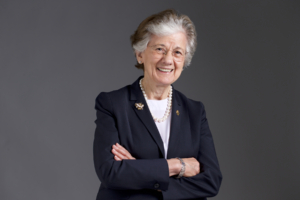Climate change and the Spread of Diseases in the Bay

Rita Colwell. Credit: University of Maryland College Park
Scientists have long predicted that warmer temperatures caused by climate change will create optimal conditions for disease-causing bacteria to spread, even in the Chesapeake Bay.
Long-time University of Maryland researcher and Johns Hopkins lecturer Rita Colwell has been studying Vibrio bacteria since the 60’s, and has found that once-rare Vibrio vulnificus is becoming more common in newly warmer waters.
Understanding Vibrio infections
Bacterial species of the genus Vibrio can cause havoc in human populations. Vibrio cholerae causes an estimated 100,000-120,000 deaths each year, mostly when people drink contaminated water. Vibrio parahaemolyticus is transmitted mainly from improperly cooked seafood. Vibrio vulnificus infections occur when a wound or abrasion is exposed to the bacterium and can be fatal. Many victims are watermen who catch and clean crabs in the Bay.
The Chesapeake Bay hasn’t suffered from a cholera outbreak since the 1930’s, when sanitation technology improved. But, over the past couple of years, doctors have been seeing an uptick in vulnificus infections across the Bay, setting off alarm bells.
While Vibrio infections can be treated with antibiotics, they can cause serious complications in people with diabetes and liver disease if Vibrio vulnificus is involved.
Vibrio vulnificus infections used to be restricted further to the south because the bacteria prefer warm, brackish waters. But as climate change warms the water of the Bay, infections are popping up all over the watershed, including as far north as the Delaware Bay.
Predicting bacterial infections
In Colwell’s 2016 paper, she proved a correlation between warmer waters and Vibrio by looking at the presence of the bacteria in stored plankton samples from the past 50 years. They developed an index called the “Vibrio-relative abundance index,” or VAI, that “measures the proportion of Vibrio bacteria relative to total bacteria and was used to evaluate temporal variations of vibrios over a multidecadal period” (Vezzulli et al 2016).
They compared changes in the occurrence and numbers of Vibrio species with sea surface temperature and found that “correlations between the Vibrio index and SST over the study period showed a positive relationship in eight of the nine study areas” across the Atlantic.
Colwell’s next step is developing a Vibrio index for the Chesapeake Bay similar to a pollen index to help alert people before they come in contact with infected waters. To accomplish this, her team is using satellite imagery to measure water temperatures and plankton levels, then using that information to feed a model that predicts Vibrio abundance.
She also hopes other researchers will continue taking DNA from plankton samples stored around the world to understand the rise of bacteria in warm waters because these bacteria have zooplankton as their hosts. “It would be very instructive,” she said, “and it would provide powerful evidence of a direct effect of global warming on human health.”
The big picture on climate change
It takes a long time for new technology to be used to inform people and make decisions on public health. Colwell lamented that when she was first reporting twenty years ago on discovering that cholera epidemics could be predicted using satellite sensors and that remote sensing made it possible to monitor and predict Vibrio diseases, it was considered “way out of the box.” “It seems that a paradigm shift takes about 20 years,” she added.
While vulnificus isn’t as famously deadly as cholera, Colwell warns that it can still be fatal and extremely damaging to victims. “The bacteria deserves respect and attention.”
Stay tuned for Colwell’s book, due out next year, about her journey as a female researcher, infectious disease, and women in science. While reflecting on her time in Maryland studying these issues, she mused, “I’ve really had an ideal opportunity. The support of Maryland has been fantastic.”
